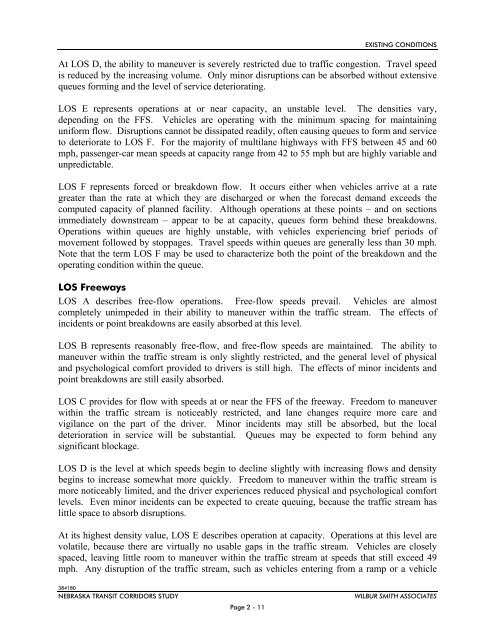NTRAC Final Study - Nebraska Department of Roads - State of ...
NTRAC Final Study - Nebraska Department of Roads - State of ...
NTRAC Final Study - Nebraska Department of Roads - State of ...
You also want an ePaper? Increase the reach of your titles
YUMPU automatically turns print PDFs into web optimized ePapers that Google loves.
EXISTING CONDITIONS<br />
At LOS D, the ability to maneuver is severely restricted due to traffic congestion. Travel speed<br />
is reduced by the increasing volume. Only minor disruptions can be absorbed without extensive<br />
queues forming and the level <strong>of</strong> service deteriorating.<br />
LOS E represents operations at or near capacity, an unstable level. The densities vary,<br />
depending on the FFS. Vehicles are operating with the minimum spacing for maintaining<br />
uniform flow. Disruptions cannot be dissipated readily, <strong>of</strong>ten causing queues to form and service<br />
to deteriorate to LOS F. For the majority <strong>of</strong> multilane highways with FFS between 45 and 60<br />
mph, passenger-car mean speeds at capacity range from 42 to 55 mph but are highly variable and<br />
unpredictable.<br />
LOS F represents forced or breakdown flow. It occurs either when vehicles arrive at a rate<br />
greater than the rate at which they are discharged or when the forecast demand exceeds the<br />
computed capacity <strong>of</strong> planned facility. Although operations at these points – and on sections<br />
immediately downstream – appear to be at capacity, queues form behind these breakdowns.<br />
Operations within queues are highly unstable, with vehicles experiencing brief periods <strong>of</strong><br />
movement followed by stoppages. Travel speeds within queues are generally less than 30 mph.<br />
Note that the term LOS F may be used to characterize both the point <strong>of</strong> the breakdown and the<br />
operating condition within the queue.<br />
LOS Freeways<br />
LOS A describes free-flow operations. Free-flow speeds prevail. Vehicles are almost<br />
completely unimpeded in their ability to maneuver within the traffic stream. The effects <strong>of</strong><br />
incidents or point breakdowns are easily absorbed at this level.<br />
LOS B represents reasonably free-flow, and free-flow speeds are maintained. The ability to<br />
maneuver within the traffic stream is only slightly restricted, and the general level <strong>of</strong> physical<br />
and psychological comfort provided to drivers is still high. The effects <strong>of</strong> minor incidents and<br />
point breakdowns are still easily absorbed.<br />
LOS C provides for flow with speeds at or near the FFS <strong>of</strong> the freeway. Freedom to maneuver<br />
within the traffic stream is noticeably restricted, and lane changes require more care and<br />
vigilance on the part <strong>of</strong> the driver. Minor incidents may still be absorbed, but the local<br />
deterioration in service will be substantial. Queues may be expected to form behind any<br />
significant blockage.<br />
LOS D is the level at which speeds begin to decline slightly with increasing flows and density<br />
begins to increase somewhat more quickly. Freedom to maneuver within the traffic stream is<br />
more noticeably limited, and the driver experiences reduced physical and psychological comfort<br />
levels. Even minor incidents can be expected to create queuing, because the traffic stream has<br />
little space to absorb disruptions.<br />
At its highest density value, LOS E describes operation at capacity. Operations at this level are<br />
volatile, because there are virtually no usable gaps in the traffic stream. Vehicles are closely<br />
spaced, leaving little room to maneuver within the traffic stream at speeds that still exceed 49<br />
mph. Any disruption <strong>of</strong> the traffic stream, such as vehicles entering from a ramp or a vehicle<br />
384180<br />
NEBRASKA TRANSIT CORRIDORS STUDY<br />
Page 2 - 11<br />
WILBUR SMITH ASSOCIATES

















